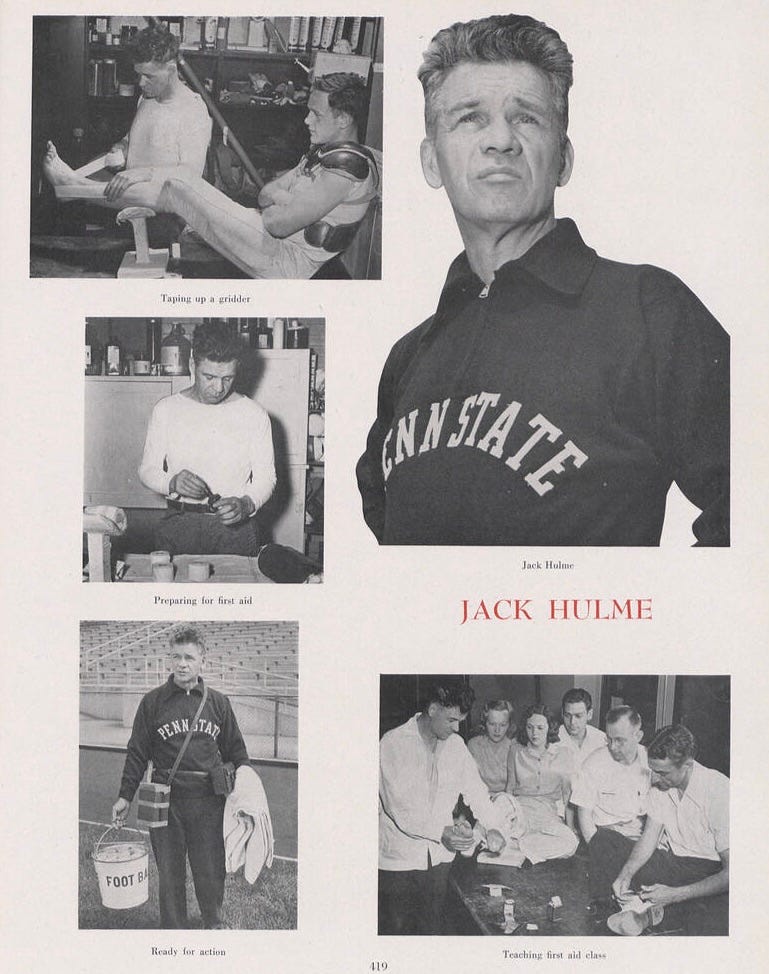Today's Tidbit... Football And Paper Cups
In July 2022, when Football Archaeology was starting, I published Today's Tidbit... Football and Water, which provided a few images of how teams doled out water to players back in the day. I promised to return with a full article describing football's water conundrum but forgot to return to the topic until today. I had previously covered football's focus on water discipline (i.e., denying players access to water) in How Football Became Football, so I did not feel too bad about my slipup.
The water discipline practice was terribly misinformed and undoubtedly led to players dying on the field from wearing heavy water-absorbing gear while being denied water. It was once a common practice, and more than one old-time coach is glorified today for his disciplined practices, which included denying his players water.
We know better today, thanks largely to researchers at the University of Florida who invented Gatorade in the 1960s. Their testing and supply of Gatorade to a team that won several come-from-behind games convinced people that replenishing players' bodies had performance benefits. It took a couple of years, but the floodgates soon opened, and nearly every football player suddenly had access to water.
So, I recently came across a 1946 image and caption regarding a water dispensing kit invented by Penn State's trainer, Jack Hulme. Hulme's invention attempted to solve the age-old problem of trainers taking a water bucket onto the field from which players refreshed themselves by scooping water with a shared ladle. The same bucket often contained a sponge to squeeze over players' heads to help them cool down. The same sponge wiped blood from cuts and bloody noses in the days before face mask-wearing was widespread. After cleaning the bloody mess, they tossed the sponge back into the water bucket, from which future ladling for refreshment occurred.
Apparently, Hulme recognized that the current water dispensing system needed improvement. He devised a tray containing a series of metal cups that sat atop the sponge bucket.
Hulme's approach seemed like a vast improvement over the prior method, but I first wondered why he did not use paper or plastic cups rather than metal cups that required sanitizing. That thought lasted several microseconds before I asked myself when paper cups became a thing.
That question led me to Lawrence Luellen, an attorney and inventor from Boston, who invented the modern paper cup in 1907. Originally called Health Cups, Luellen and partners changed the name to Dixie Cups in 1916, followed by Dixie ice cream cups in 1923. (Dixie ice cream cups are individual ice cream servings in cups with a tabbed paper lid and a wooden spoon.) While Dixie Cups were reasonably successful, things really took off when the fast food industry boomed in the late 1940s.
So, why would Hulme create a device using metal cups nearly forty years after the paper cup's invention? As it turns out, some football coaches back then were proponents of giving players water and preferred it to be sanitary. One of those coaches was Percy Haughton, Harvard's coach from 1908 to 1916, the same time, fellow Bostonian Lawrence Luellan was getting the paper cup business going. During games, Haughton had trays of water-filled paper cups delivered to players on the field. Other coaches followed his example, and at least one used his drinking from a paper cup on the sideline to illegally signal his quarterback to throw a pass, an act that fell afoul of the coaching from the sideline restrictions.
During the 1920s and 1930s, the paper cup business grew as consumers happily paid the local druggist a penny to take their soft drink off-premise in a paper cup rather than drinking it from the glass at the counter. WWII came along, and its paper shortages led to paper cup shortages, so Hulme's metal cup tray invention likely dealt with wartime conditions that no longer applied when his invention received publicity in 1946.
Unfortunately for Hulme and Penn State, the WWI vet, former YMCA physical director, and Westminster trainer before heading to Penn State in 1936, fell ill shortly after the article touting his invention came out. He passed away one month later.

Paper cups eventually gave way to squeezable bottles that do not require direct player contact, and we now consider water access a non-issue. While that is thankfully the case today, I hope this story has quenched your thirst for knowledge of football history for yet another day.
CFL Alert: The CFL preseason starts on Monday at 4 PM Eastern. It's an entertaining game. The rules differ enough from American football that U.S. coaches should watch it if only to challenge some of their thinking about their game. Stream it here for free. (FYI: The CFL does not sponsor this blog, though they are welcome to do so.)
Football Archaeology is reader-supported. Click here to buy one of my books or otherwise support the site.





One of your very best ones, Tim! Anybody over age 50 who has ever put a helmet on has likely stared longingly at water delivery devices on the sidelines like a lost lover!
One side point: my guess is that Occidental photo shown was taken during the ‘48/‘49 Raisin Bowl in Fresno…unless L.A. experienced a rare polar vortex of some sort.
I had a granduncle who played collegiate football in the 1930s and one year in the NFL. I have to wonder how he managed his energy given the time period, and seeing that pic does give sobering thought.